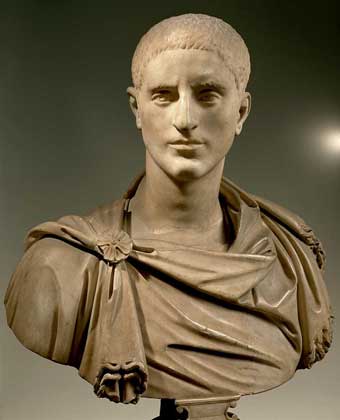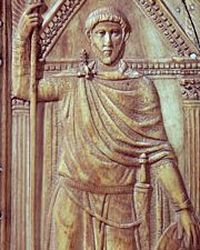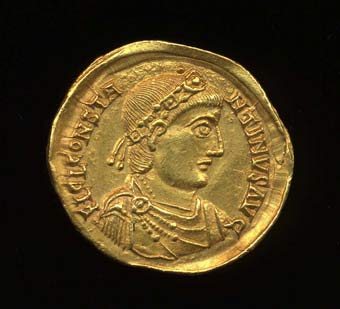|
Old King Cole Submenu |
According to
local tradition in Kyle, the district name derives from the ancient king,
popularly known today as Old King Cole. Much confusion arises because there
were three famous King Coles of
The first was
Coel ap Mor (Marius?), semi-mythological, if he lived, probably lived in the 2nd
century. Traditionally, he was the father of Lucius and maternal great grandfather of Coel
the 2nd's
wife, Strada.
The second Coel the Dux Camelodunum (Colchester); possibly a Roman Decurion. He
is reputed to have lived in the 3rd century and his daughter of legend, St. Helena, married
the Emperor Constantius Chlorus. His grandson was the Emperor Constantine
the Great.
The last, and most well known was Coel Hen (the Old) aka Coelius (of
Ayrshire) whose name was given to the Kyle Districts according to local
tradition. He is the Cole most likely to have been a real personage. He reigned in the early 5th century and was probably the last of
the Roman Duces Britanniorum.

Nursery Rhyme
The nursery rhyme first appeared in print in 1709 in a volume titled "Useful Transactions of Philosophy" by Dr. William King. It is clear that by 1709 the verse already had a reputation for great antiquity. It is believed that the composer was possibly referring to the second King Cole, but the three Coles were pretty thoroughly confused with each other.
Old King Cole was a merry old soul,
And a merry old soul was he.
He called for his pipe, and he called for his bowl,
And he called for his fiddlers three.
Now every fiddler had a fine fiddle,
And a very fine fiddle had he.
Tweedle dum, tweedle dee, went the fiddlers three,
Tweedledum-dee, dum-de-dee, dum-de-dee.
Old King Cole was a merry old soul,
And a merry old soul was he.
He called for his pipe, and he called for his bowl,
And he called for his harpers three.
Every harper had a fine harp,
And a very fine harp had he.
Twang-a-twang, twang-a-twang, went the harpers three,
Twang-a-twang, twang, twang-a-twang-a-twee.
Old King Cole was a merry old soul,
And a merry old soul was he.
He called for his pipe, and he called for his bowl,
And he called for his drummers three.
Every drummer had a fine drum,
And a very fine drum had he.
Rub-a-dub, rub-a-dub, went the drummers three,
Rub-a-dub, dub, rub-a-dub-a-dee.
Oh there's none so rare
As can compare
With King Cole and his fiddlers three.
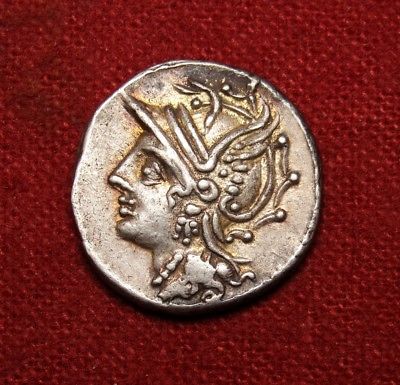
Roman Denarius. Coelius Caldus
The Historical Coelius (of Scotland), Dux Britanniarum [?383-420]
by David Hughs
"Coilus "Votepacus", the Welsh Cole/Coel "Godebog"/"Guotepauc", Coilus/Caelius "Votepacus", called "protector" may be identified with Coelestius "Senex", the "Dux Britanniarum", formerly in Roman service, who was descended from pre-Roman British royalty and was the representative of one of the secondary-branches of the Old British Royal House. His epithet "Votepacus"/"Guotepauc" means "The Splendid" or "The Excellent."
Cole "Godebog" (Coilus
'"Votepacus") has sometimes been called
Cole "Godebog"
held sway in
It is recorded
that Cole "Godebog" launched a massive attack on Ayrshire against Quintillus
of Strathclyde, and on
Cole "Godebog" was caught by surprise by Quintillus [allied with Fergus] who made a night-attack on Cole's encampment and scattered Cole's Army in flight, and Cole "Godebog" drowned in a bog during the rout of his forces Year 420. This battle, according to tradition, took place in Strathclyde. Cole "Godebog" was buried under a circular mound at Coilsfield, in the parish of Tarbolton.
The descendants
of Cole "Godebog", called "the sons of Godebog", or "the Coelings", or The "Gwyr
Y Gogledd" ("Men of the North-Country"), developed into numerous branches
over time and were the rulers of lands throughout
Coylus he fled unto the river Donne,
Quher drownet were many yt thair did runn
And northward held, quhil they came to a muir
And thair was slayet be Scots that on him fuir
Fergus he followet, and came right haestillie,
Quhair Coyle was killet and all his hole armie:
The country people frae thensefor does it call
Coylsfield in Kyll, as ever more it sall.
John Bonar 1631
The Mysteries of Old King Cole
The Pipe, The Bowl, The Tomb, The Crys, His Lineage
Thrice hallow’d the land of our Minstrel’s
birth,
The fields that once gladden’d his eye,
The echoes that rang to is woe and his mirth,
And the mountains that bounded his sky!
Lo! there is the scene of his own Vision-dream--
The mantle his Coila then wore,
Still flower’d with the forest, enstriped with the stream,
And fringed with the fret of the shore!
HEW AINSLIE.
"He called for his pipe..."
"The Sheriffdom of Ayr embraces in its midst Kyle, named from Coil, King of the Britons, whom Fergus, first King of the Scots, defeated in a severe battle and killed there in 325 BC [sic, this date incorrect]. Several monuments of this famous victory are even now in existence. The plain in which it was fought retains the King’s name; and not far off the church of Coylton; the River Kyle, which flows into the Ayr about four miles above the market-town, quite a famous name for the river; there is also in the vicinity Fergus Loch, near which the Scots pitched camp, and finally it was by the good fortune of that battle, that the Scots offered the kingship to Fergus and swore in a sacred and solemn ritual to obey him and his successors; from him in an almost continuous line 108 Kings down to Charles, beheaded in 1649 at London in England, have held the Kingdom. On the field of battle a curved trumpet, resembling a horn in shape and extremely melodious, was dug up many years later; it is used by the lairds of Caprington, whose principal seat in that region is called Field of Coil, in the vernacular Coilfield, to summon their tenants and workers."
Source: Blaeu Atlas section: Kyle. Cvnninghamia
A replica of the horn from Coilsfield is in the collections of the National Museums of Scotland while the original is in a private collection. Experts disagree as to dating the horn with estimates ranging from Coelius’ era in the early Dark Ages to the 1st cent. AD. It is called the Caprington Horn from Caprington Castle where it was kept.
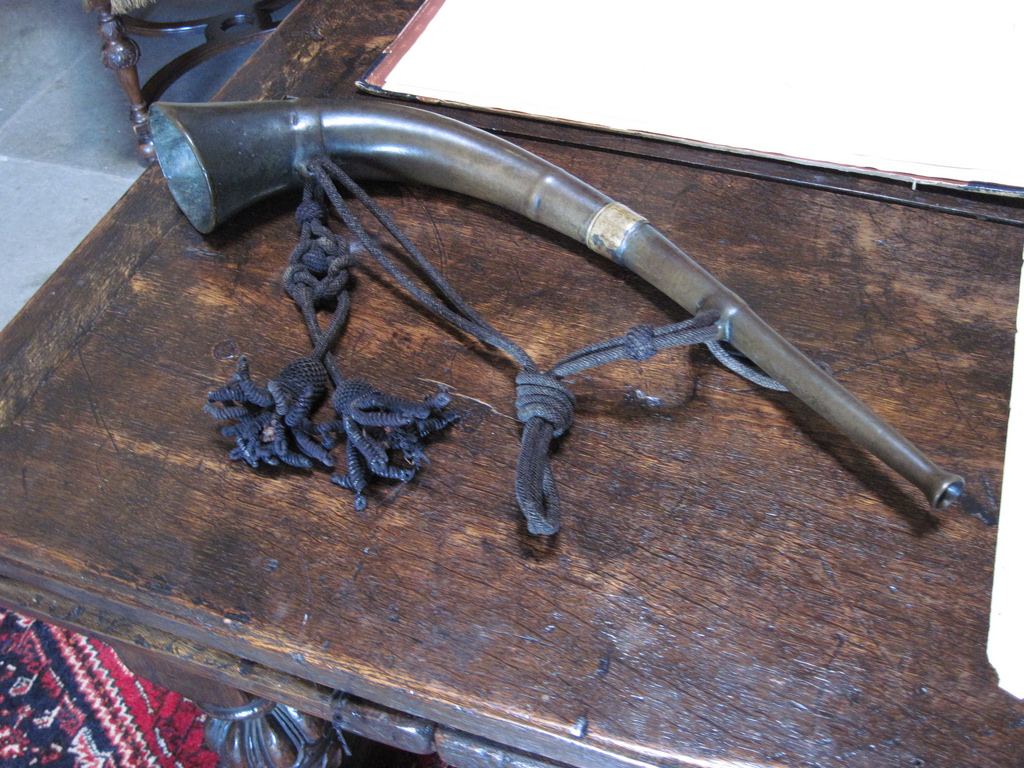
The Caprington Horn (from Coilsfield)
Smoking pipes were not invented at the time of King Coelius. If he ever did call for "pipes" he would have been calling for something that made noise. Of course the Scottish love of pipes even today is no secret! Since the above horn was dug up at the site of Coel's last battle it might even have been his. May we be permitted poetic license in saying that, as far as anyone knows, there exists only one object in the world which can be claimed to be "The Pipe" of Old King Cole. It is pictured above.
"The Scots have a custom, when assembled well dressed, each having a large horn slung around his neck in the manner of hunters, and when they blow all together, the horns being of different sizes, the noise is so great it may be heard four miles off, to the great dismay of their enemies." --- the 14th century French historian, Froissart.
According to modern researchers, ancient bronze horns might have been used for music as well as war since a great variety of tonal possibilities have been discovered.
A CD which includes the sound of the actual Caprington Horn, and a photo, is available. It is called the Kilmartin Sounds of Ancient Scotland CD (Tract 22)
The Caprington Horn (from Coilsfield) -- Photo
"
...and he called for his bowl..."In 1837 a group lead by Rev John Ritchie excavated the tomb reputed to be that of King Coelius. The following is an extract from the records of the National Museum of Scotland
"The urn from the central burial found in 1837 was taken to Eglington Castle and may well have been one of the 'three ancient Urns of baked clay, very much broken, found in the neighbourhood of Eglington Castle' which were presented to the Society of Antiquaries of Scotland in 1846. The Catalogue of the National Museum of Antiquities of Scotland (1892) mentions one urn (RMS EA19) 'from a tumulus near Eglington Castle'. The size and description of the urn from King Coil's Grave approximates to the Eglington Castle urn and, in the absence of any other records of burials around Eglington Castle, they are likely to be the same vessel; Coilsfield appears to have been part of the Eglington Estate at this time.
RCAHMS 1985"
Current records list only one urn in existence now. Presumably the others were too damaged to be recorded?
We can say that the only artifact in existence which could possibly be claimed to be "The Bowl" of Old King Cole sits in the National Museum of Scotland, item number RMS EA19.
According to Tradition, King Coelius is buried under the mound in Coilsfield Park, Tarbolton, near the remains of Montgomery Castle, formerly known as Coilsfiled House.
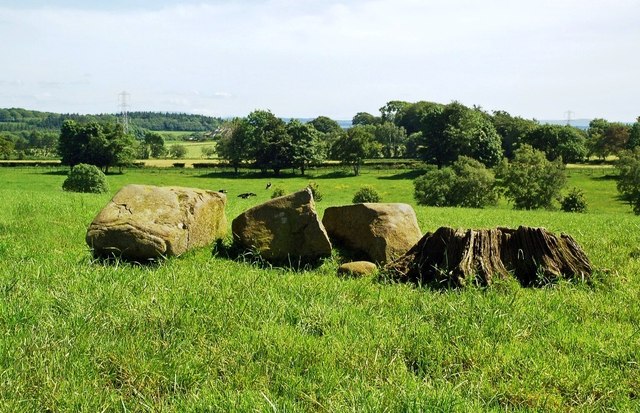
King Coil's Grave, a tumulus which was surmounted by two large stones, was opened in May 1837. The centre of the mound was occupied by boulders, some of which were of considerable size. A circular flagstone about 3ft in diameter, was encountered at a depth of about 4ft. Under this stone was a quantity of yellow clay, then a small flagstone laid horizontally, covering the mouth of an urn filled with burnt bones. In removing the clay surrounding the urn, several small heaps of bones were found under flat stones, surrounded by the clay. Other urns (Wilson states a total of four) were also found. They disintegrated on exposure to the air. The urns were plain apart from an edging or projecting part 1/2in from the top, and were flower-pot shaped. The largest was 7 7/8in in height and the same in diameter. The NSA also notes that "pieces of ancient armour and fragments of bones" had been ploughed up here many years previously.
NSA 1845 (D Ritchie); D Wilson 1863
Source: West Of Scotland Archaeology Service
According to some sources, the remains discovered in the mound in 1837 were "removed to the Church at Coylton," but most local parish records of this time period were destroyed in a fire. If these remains were indeed removed, no record of their location is known to exist.
Judging solely from the above account made by Rev John Ritchie in 1837, most experts believe this mound to be a Bronze Age tomb and therefore not that of Coelius.
Before rushing to discount the ancient reports, should we not consider all possibilities? Was Coelius perhaps buried at the site of a pre-existing mound? The fact that the bones were recorded as having been burnt has led to the conclusion of a much earlier, and non-Christian burial. Can we be certain Coelius – or whoever buried him – was Christian? Non-Christian Romans in Britain buried their dead, as ashes, in urns (see photo below).
Since his followers had been scattered, was Coelius buried by his own men or by his foes, the (Pagan) Pictish or Scots/Irish? Certainly, no thorough modern study has ever been undertaken. No carbon dating was ever done. No other excavations around the mound were ever conducted.
A Roman Burial Urn, 1st Cent AD, Wales
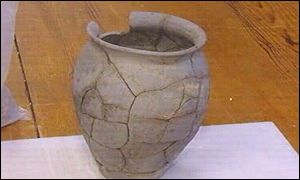
http://news.bbc.co.uk/1/hi/wales/1684894.stm
The ancient Chinese believed that the tombs of our ancestors are central to the fortunes of later generations. One way to attack an enemy was to desecrate the tomb of his ancestors and thereby attack his fortune. Is it right that Coelius, one of the earliest High Kings of Britain and progenitor of many royal families should be so neglected and abandoned?
The mystery of the Tomb of King Coelius is many fold. Were the remains found by Rev Ritchie those of Coelius? If so, were they "removed to the Church at Coyton?" If so, can they be located in a local Church? Or do does Coelius still rest under the cairn at Coilsfield?
Later Welsh tradition associates Cunedda with Carlisle, and relates that he held court there, had a troop of 900 horse and wore ‘The Crys,’ possibly a golden diadem or belt, the insignia of the former Dux Britanniarum. ----- R. Cunliffe Shaw, "Post Roman Carlisle and the Kingdoms of the North-West"
What was the Crys, the "insignia" of the Dux Britanniarum?
In modern Welsh (the language closest to that spoken in fifth century Britain), "Crys" means shirt.
Why would Mr. Shaw assume that insignia called a "shirt" would be a "belt or diadem?"
High-ranking Roman officers sometimes wore rich ring or scale mail armor. Eight solid gold scales from such a "shirt" (lorica Plumata in Latin) were unearthed near Hadrian’s wall and dated to the 2nd century (Private Collection of David Xavier Kenney). Perhaps the Crys was just such a remarkable and rich golden scale mail shirt, which came to be associated with the Dux?
Solid Gold Scales from Roman Armor, Hadrian's Wall
On the other hand mail, both ring and scale, were relatively common and well known. The word for mail in Welsh is "dur." Why wouldn’t they simply call a mail shirt by it’s name? Further, ring or scale mail was not ever technically "insignia."
Another possibility is that Cunneda, and Coel before him, wore the highly decorated "muscle" style armor worn by Roman Emperors and Commanders (see below) which had come to be associated with the Dux. This type of "shirt" would have been extremely rare and distinctive on the northern frontier. Perhaps the Dux was the only one in their memory who was ever seen to wear one in their "North Country?" These muscle shirts were only ever worn by commanders and could be considered to be "insignia." H. Russell Robinson suggests that the muscled cuirass (body armor), made of boiled leather, was probably in use well into the 5th Century AD and plenty of odd looking, surviving fixtures and fittings in copper alloy suggest that they may have been attached to leather cuirasses - including the famous gold & garnet shoulder clasps that were found in the much later Sutton Hoo Saxon ship burial.
Interestingly, according to Nennius the title Dux Britanniarum was still in existence at the time of King Arthur, and the Dux "fought along side the Kings of Britain."
Augustus of Primaporta Wearing an Embossed Cuirass
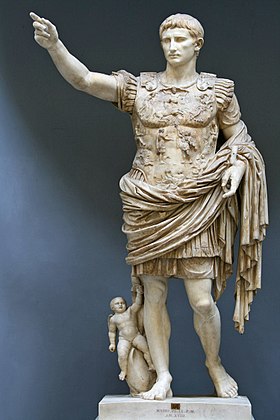
The Lineage of Old King Cole
The ancestry of Coel Hen (the Old) is given in the
pedigree of the Kings of Bryneich in the Harleian MS 3859 as:
Beli (Beli Mawr “the Great”)
Aballac (afallach)
Eudelen
Eudos
Ebiud
Outigern
Oudecant
Ritigern
Grat (Gratian)
Urban
Telpuil
Teuhant
Tecmant
Coyl Hen Guotepauc
His pedigree is recorded in the Kings of South Rheged in the Achau
Brenhinoedd a Thywysogion Cymru as follows:
Beli Mawr
Aflech
Avallach
Enddolev
Endos
Enied
Endeyrn
Endigant
Rydeyrn
Rriuedel
Gradd (Gratian)
Vrban (Urban)
Tyddbwyll
Deheuwaint
Tegvan
Koel Godebawg
The connection of King Coelius with other royal lines including with King Arthur is proposed as follows (below identified as Coel Hen -- "Coel the Elder"):
Merlin
As to the historical Merlin, if he
existed, modern writers such as Ward Rutherford and Nikolai Tolstoy think he
may have been a latter-day Druid and so took part in shamanistic practices.
Jung and von Franz also see shamanistic elements in the story of Merlin.
This contrasts with the earlier theory of E. Davies that Merlin was a god
(the evening star), and his sister Ganieda a goddess (the morning star).
There is some evidence that Merlin may originally have been a god, for in
the TRIADS, we are told that the earliest name for Britain was Merlin's
Precinct, as though he were a god with proprietorial rights. Geoffrey Ashe
would connect him with the cult of the god Mabon. Because of his association
with stags, there may be a connection with Cernunnos, the Celtic horned god.
Merlin's mother was called Aldan in Welsh tradition. The Elizabethan play
THE BIRTH OF MERLIN - which may have been partially authored by Shakespeare
calls her Joan Go-to-'t. That he had no father does not seem to be a feature
of Welsh tradition in which he is given the following pedigree: Coel
Godebog - Ceneu - Mor - Morydd - Madog Morfryn - Myrddin (Merlin).
He was also said to be the son of Morgan Frych who, some claimed, had been a
prince of Gwynedd. Both Welsh poetry and Geoffrey have him speaking with
Taliesin, with whom he seemed to be considerably connected in the Welsh
mind. Thus one Welsh tradition asserted he first appeared in Vortigern's
time, then was reincarnated as Taliesin and reincarnated once more as Merlin
the wild man. The idea that there were two Merlins, wizard and wild man, is
found in Giraldus Cambrensis (the Norman-Welsh chronicler of the twelfth
century), doubtless because of the impossibly long lifespan assigned to him
by Geoffrey of Monmouth. A modern relic of the Merlin legend was to be found
in the pilgrimages made to Merlin's Spring at Barenton in Brittany, but
these were stopped by the Vatican in 1853.
Was Old King Cole a Member of the Roman Coelius Gens?
A Speculative Article by JRM Kyle
The name Cole, or "Coel" is certainly Celtic British but few have highlighted that Coel - spoken as "Coelius" in Latin - is also an equally well known Roman Family (Gens) name, and therefore Coel, or Coelius might have been the Roman family name of King Cole of Ayrshire, Scotland (although PF Turner in "The Real King Arthur," for one, mentions this possibility in passing).
King Cole is hypothesized to have been
the last Roman Dux Britanniarum ruling northern
SEE Britannia:
"The Early British Kings of what is now
Welsh tradition holds that they all had a common ancestor in Old King Cole of nursery rhyme fame. He appears in ancient records as Coel Hen (the Old) and his name seems to ultimately derive from the Roman, Coellius. This fits in well with the time period in which it has been calculated that he lived: right at the end of the Roman administration (very late 4th century).
Considering
the regions over which Coel's supposed descendants ruled, his own sphere of
influence must have covered a vast area from
King Cole
According to PF Turner, the Roman army in North Britain by Coel's time, aprox 400AD, had devolved into a hereditary militia or "National Guard" with solders serving when needed in exchange for grants of land. The Romans had also instituted a policy of sending officers north of the wall to rule the allied tribes as regents or even proxy kinglets. Coelius would have maintained a core troop of equites or knights so his administration was an early feudal arrangement. He would have been understood by the native British to be a king who possibly owed allegiance to a greater king either in the South of England or in Rome. There is no records of any great barbarian invasion or dramatic collapse in the north when the remnants of Roman administration finally evaporated in 410. Coelius, having been on his own for years anyway, presumably remained in power at his headquarters at York or Aeron (Ayr), possibly changing his title from Dux to King.
If we accept that Coelius was the Dux Britanniarum, we might question whether that crucial position would have been bestowed on a purely native British/Celt --descended from "pre-Roman royalty" or not -- since, like most higher Roman posts, it would have probably been granted on a largely political basis. Generally, military service in the higher ranks was a stepping stone or prize in a political career. The prerequisite would usually be close connection to the court of the Emperor or to the patrician families of the Senate (with, however, many exceptions in those troubled times such as Constantine III, an ordinary soldier).
Take, for example, Magnus Maximus, or Macsen Wledig as he was known to the British. Magnus was the Comes Britanniarum or Commander of the Army stationed in Britain just prior to Coelius. Coelius might possibly have served as the Dux under Magnus. Magnus’ background, possibly maternal, was Spanish, born in Iberia, a descendant of the Emperor Constantine the Great, and a relative of Comes Theodsius, father of the future Emperor Theodosius the Great. Magnus at one point decided to proclaim himself Emperor and marched to his eventual death in Italy in 388.
Coelius might have also been installed by, or served under, a succession of short lived usurpers after Magnus who briefly came to power in Britain or by Stilicho, Magister Militum (Supreme Commander) and Regent over the Western Empire including Britain 396-402AD.
|
Magnus Maximus
|
General Stilicho
|
Constantine III
|
It is not an unreasonable stretch to imagine that the last of the Roman Dux Britanniarum, sole military commander of North Britain, could have been a member of the ancient and prominent Roman Coelius Clan, and that he could therefore have been referred to by his family name; Coelius -- or "Coel" in the native tongue. Since Coelius held power for a number of decades, while a half dozen generals and usurper/claimants of Britain came and went, this would bolster the argument that he was not someone who came to his position by chance, but rather that he was well versed in the workings of the Empire and therefore that Coelius was either Roman or thoroughly Romanized.
Ancient Brythonic genealogies record that Coelius' father was born with the native Celtic name of Tegfan. In Latin, this becomes Tasciovanus, a name known to have been in use
in
Given that we accept the Brythonic/Welsh genealogies as at least partially accurate, there are a variety of possible explanations for Coelius’ lineage. Since there was much intermarrying in Roman Britain, having both a Celtic and a Roman lineage would not be unthinkable. In fact it was Roman policy to send officers into the northern tribes beyond the wall to act as local tribal regents and possibly intermarry with local nobility. Another explanation is that of adoption, which was known to occur to notable Roman figures (for example when Gaius Octavius Thurinus was adopted by his great-uncle, Julius Caesar). Adoption also occurs in the Celtic tradition when a man marries a woman of much higher rank; The husband will take the family name of the wife in this case. In Roman practice, the Clan name was the nomen or middle name, so it is possible that Coelius’ ancestors could also have been of the Coelius family but Brythonic oral tradition only recorded their first or last names -- their cognomen or praenomen. Finally, his name being identical to the Roman Gens could be simple coincidence. However, if there was no connection to the Roman family, Coelius might have been constantly explaining that he was "no relation to the Coelius family of Rome!"
Roman Gens
In early Rome, the Gens, meaning family or clan, were quite powerful. Gens were part of the legal and political structure of Rome and the Clan Leader or Princeps Gentis exerted much authority. Families participated in their own religious rites (Sacra Gentilica), maintained their own temples and had their own laws (Regula Gentilicia). By the time of Coelius, however, the Gens system had lost much of its power.
The Gens Coelius
Mastarna Frees Caelius Vebenna (below)
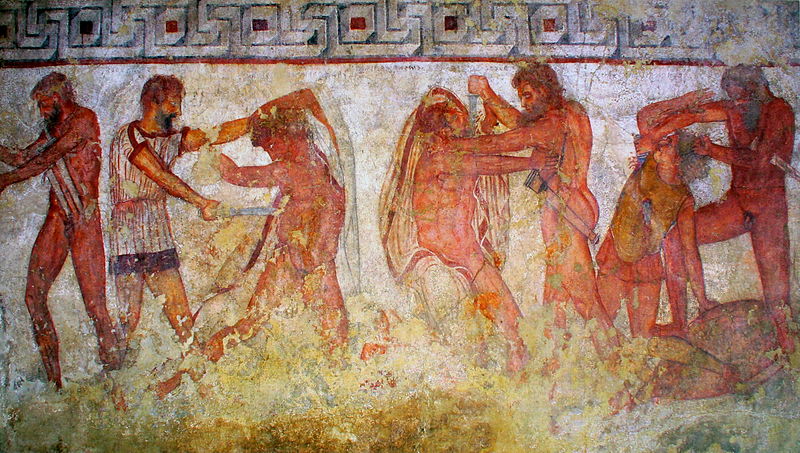
A prominent Roman family, or “Gens,” which included one Emperor, many
Senators, Counsels and Generals, was the Gens Coelius, also written equally as
Caelius.
In Latin, Coelus/Caelus means heaven or sky. Our word celestial is a
derivation. In Latin, Gens
Coelius would be understood to sound like "The Heaven Clan." The Coelius Gens name
One member of the this Gens commanded the XX legion in Britain in the first century and briefly took control of the island. The episode is recorded by Tacitus as follows:
"The governor of
Cornelius Tacitus The Histories I.lx - translated by C.H. Moore (1925)
Notable members of the Coelius Gens, included:
Sestertius of Emperor Caelius Balbinus
Emperor Caelius Balbinus
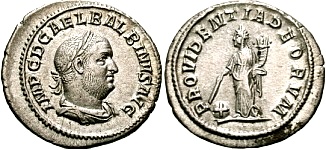
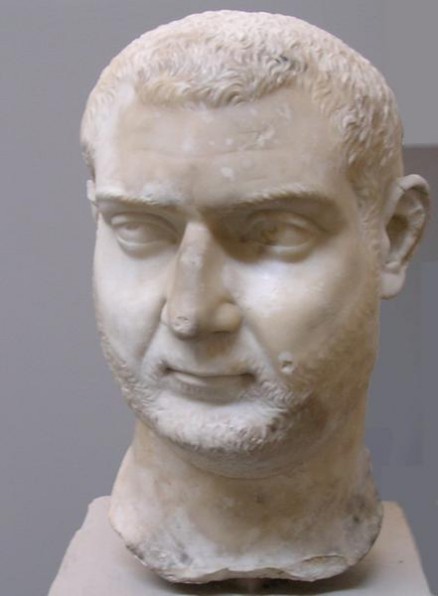
Emperor Celius was a patrician, a Salian priest, twice a consul, and proconsul in Asia. He held governorships of no less than seven provinces, the last two being Asia and Africa. In 238, when the Senate led a rebellion of the Italian cities against Maximinus (emperor 235–238), it placed the government in the hands of a board of 20, one of whom was Caelius Balbinus, and then chose Caelius Balbinus and Pupienus Maximus to be joint emperors.
Emperor and Pontifex Maximus, Decimus Caelius Cavlinus Balbinus (3rd Cent.);
Gaius Caelius Rufus, Early Imperial Roman Consul;
Lucius Coelius Antipater who wrote seven books on the Punic Wars;
Marcus Caelius Rufus, Praetor under Julius Ceasar and famously, friend of Cicero;
Q. Roscius Coelius Pompeius Falco, Procurator of Judea (105-107);
Marcus Caelius, Legate, XVIIIth Legion, 70AD
C. Coelius Caldus, Cousul and author of the Lex Coelia (the Law of Coelius);
Roscius Coelius, General of the Legio XX who briefly took control of Britain circa 70AD;
Caelius Sedulius, 5th Century Christian writer whose works include: Carmen Paschale, Elegia and Veteris et Novi Testamenti Collatio
Caelius Aurelianus, 5th century AD, usually considered the greatest Greco-Roman physician after Galen. He is now thought to rank second only to the physician Celsus as a Latin medical writer. His most famous work, De Morbis Acutis et Chronicis;
Possibly Coelius of Ayrshire circa 400AD, Dux Britanniarum?
and the genarch, Caelius Vivenna, the Etruscan general, among others.
If the connection to the Gens Caelius is accepted then the Kyle family would be related to the family names Caelius and Coelius which both still exist, primarily in continental Europe.
Denarius of C. Coelius Caldus (below)
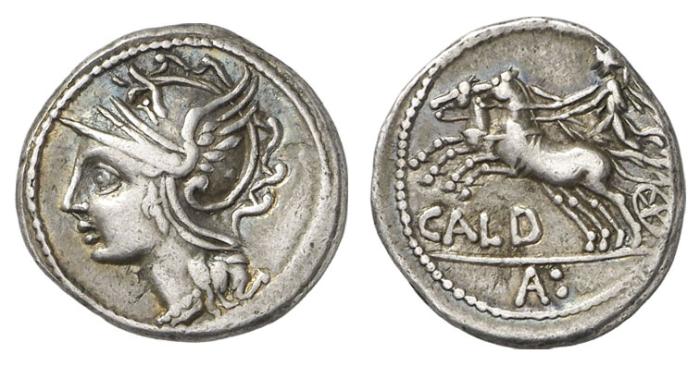
51 BC. Head of the consul C Coelius Caldus left, standard inscribed HIS behind, standard with boar's head below chin / Veiled figure seated left behind (or on) a table inscribed L CALDVS VII VIR EPVL, between two trophies, C CALDVS to left, IMP.A.X to right, CARVS III VIR below. Cr437/2a, Syd 894.
In Rome, moneying was a form of political advertisement. The issuer of this Denarius was C. Coelius, a Senator and Quaestor around 50 BC. The veiled-figure-between-trophies sits at a lectisternium (from Lat. lectum sternere, to spread a couch). In ancient Rome, a lectisternium was a propitiatory ceremony consisting of a meal offered to gods and goddesses, represented by their busts or statues, or by portable figures of wood, with heads of bronze, wax or marble, and covered with drapery. The Sibylline books, which decided whether a lectisternium was to be held or not, were of Greek origin; the custom of reclining at meals was Greek. Some, however, assign an Etruscan origin to the ceremony. Was this a reference to the Etruscan origin of the family? The standards are meant to commemorate the moneyer’s grandfather’s (also a C. Coelius), conquests in Spain. IMP A X - I means his ancestor was proclaimed Imperator of the "A X" meaning the Augur Decimvir; someone in charge of interpreting the signs, foretelling the future. L CALDVS VII VIR EPVL --- The EPVL refers to his father, L. Coelius, being a member of the seven member council (Septemviri Epulones ) of the office of Epulo Jovis, a religious official of the cult of Jupiter. CARVS III VIR below refers to someone who was a member of a triumvirate, a three member ruling council. Perhaps the Carus is the "C" in C. Coelius?
Monument to Marcus Caelius, Legate, XVIIIth Legion, 70AD
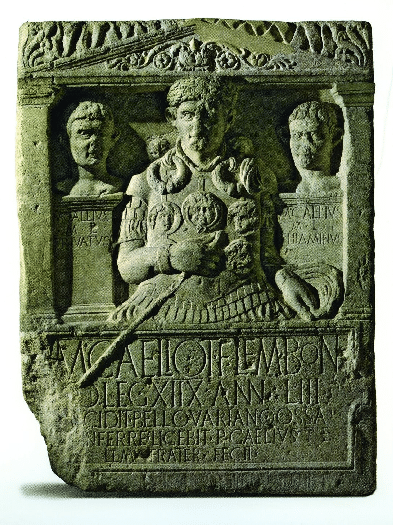
The legate Marcus Caelius
was the commander of the XVIIIth legion, which fought in A.D.
70 in the vicinity of the Roman camp Vetera Castra, near the settlement
Xantheneum and in the neighborhood of modern Dusseldorf. The head of the
legate is decorated with a wreath (Corona), two garlands with a collar
(Torques) falling from the shoulders, on the arms are bracelets (Armillae)
and on the breast are circular medallions (Phalerae), fastened to the armor
by clasps. Five of these are placed in a line one above the other. In his
clenched right hand the legate grasps the point of a blunt javelin (Hasta
Pura). All these decorations, including the javelin, are badges and
distinctions, which the legate had been awarded for valor.
Material: Gold
Era:1st BC to 1st Century AD
This is a rare Roman Knight's Gold Band Circa Late 1st Century BC to early 1st Century AD. Worn on the left ring finger the wearing of the gold band was the exclusive right of the Roman Aristocracy. Caesar Augustus began the practice of the Imperial gold band presentation to all legionary officers that were of the knights class (above the rank of centurion). The beveled ring band such as this one are of this early Imperial style.
Private Collection of David Xavier Kenney, An Antiquities Dealer from New York
CAELIUS MONS: the most south-easterly of the hills of Rome, stretching west
from the eastern plateau, from its junction with the Esquiline near the
Porta Maggiore, in an irregular tongue about 2 kilometres long and 400 to
500 metres wide. This tongue ends in two points, like promontories, an
eastern, probably called CAELIOLUS (q.v.), where the church of SS. Quattro
Coronati now stands, and a western, the site of SS. Giovanni e Paolo. South
of the Caelian is the valley traversed by the brook now called the Marrana,
part of which was the VALLIS CAMENARUM (q.v.), and on the north it was
separated from the Esquiline by the low ground that runs east from the
Colosseum. Part of the northern side of the Caelian seems to have been
called SUCUSA (q.v.), and this was probably just east of the Caeliolus. The
height of the Caelian varies considerably, being 45 metres in the Villa
Mattei and 54 in the Villa Wolkonsky.
The hill is said to have been called at first MONS QUERQUETULANUS (q.v.),
from the oak groves that covered it (Tac. Ann. iv.65), but this was perhaps
an invention of the antiquarians to explain the PORTA QUERQUETULANA (q.v.)
of the Servian wall. In the reign of Tiberius the senate voted to call the
hill Augustus mons (Tac. Ann. iv.64; Suet. Tib. 48), but this name never
came into general use. In the Regionary Catalogues the second region of the
city is called CAELIMONTIUM (q.v.). Caelius itself was explained by the
antiquarians as the name given to this hill in consequence of the settlement
upon it of Caeles Vibenna and his Etruscan companions who came to the
assistance of one of the Roman kings (Varro, LL v.46; Fest. 44, 355; Dionys.
ii.36; CIL xiii.1668, 1.21). It seems difficult to explain the existence of
Caelius mons and Caelius, the name of a well-known plebeian gens, unless
there be some connection between the two (Jord. i.1.186-188; see
SEPTIMONTIUM).
Tradition varies in ascribing the addition of the Caelius to the city to
Romulus (Varro, LL v.46), Tullus Hostilius (Liv. i.30.33; de vir. ill. 4;
Dionys. iii.1), Ancus Marcius (Cic. de rep. ii.18; Strabo v.234), Tarquinius
Priscus (Tac. Ann. iv.65), and Servius Tullius (or. Claudii, CIL xiii.1668),
and is of course without value.
Both Caelius and Sucusa were included in the Septimontium (cf. Fest. 341,
348). The later 'Servian' wall, following undoubtedly the original line,
crossed the Caelius about 250 metres west of the present church of S.
Giovanni in Laterano, and thus included the western half of the hill within
the area of the city, a condition that probably went back to the regal
period. Whether this hill ever had its own fortifications is still undecided
(Ann. d. Inst. 1871, 47; cf. Varro, loc. cit.; Jord. i.1.206; HJ 224).
In Augustus's division of the city, the Caelian fell into three regions —
the western and southern slopes into Region I, the main portion into II, and
the extreme eastern part into V. The hill was thickly populated during the
republic, and we are told of an apartment house, belonging to Ti. Claudius
Centumalus (Cic. de off. iii.66), which the owner was ordered to demolish
because it was so high as to cut off the view of the augurs. In 27 A.D. the
hill suffered severely from a fire (Tac. Ann. iv.64), and afterwards became
a favourite place for the residences of the rich, which, with their gardens,
seem to have occupied a considerable part of the whole (for the topography
and monuments of the Caelian see HJ 220-255; Pl. 428-443; RE iii.1273-1275).
CAELIOLUS or CAELIOLUM: a part of the Caelian hill (Varro, LL v.46),
appearing as Caeliculus or Caeliculum in Cicero (de Har. Resp. 32), and
probably the Caelius minor of Martial (xii.18.6). The vicus Capitis Africae,
the modern via Claudia, seems to have divided the hill into two sections,
and the smaller, eastern, section, was presumably the Caeliolus. This is now
marked by the church of SS. Quattro Coronati (Gilb. ii.32; HJ 223; BC 1914,
353; Eranos, 1923, 55). BACK
